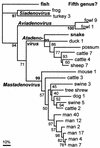First molecular evidence for the existence of distinct fish and snake adenoviruses
- PMID: 12208985
- PMCID: PMC136508
- DOI: 10.1128/jvi.76.19.10056-10059.2002
First molecular evidence for the existence of distinct fish and snake adenoviruses
Abstract
From adenovirus-like viruses originating from a fish and a snake species, a conserved part of the adenoviral DNA polymerase gene was PCR amplified, cloned and sequenced. Phylogenetic analysis showed that the snake adenovirus is closely related to the members of the proposed genus Atadenovirus, whereas the fish isolate seems to represent a separate cluster, likely a new genus.
Figures


References
-
- Bamford, D. H. 2002. Tectivirus, p. 1132-1135. In C. A. Tidona and G. Darai (ed.), The Springer index of viruses. Springer-Verlag, Berlin, Germany.
-
- Bamford, D. H., and H.-W. Ackermann. 2000. Family Tectiviridae, p. 111-116. In M. H. V. van Regenmortel, C. M. Fauquet, D. H. L. Bishop, E. B. Carstens, M. K. Estes, S. M. Lemon, J. Maniloff, M. A. Mayo, D. J. McGeoch, C. R. Pringle, and R. B. Wickner (ed.), Virus taxonomy: classification and nomenclature of viruses. Seventh report of the International Committee on Taxonomy of Viruses. Academic Press, San Diego, Calif.
-
- Benkö, M. 2000. Comparison of the genome of ovine adenovirus types 1 through 5 by restriction enzyme analysis and DNA hybridisation. Acta Vet. Hung. 48:477-484. - PubMed
-
- Benkö, M., and B. Harrach. 1998. A proposal for a new (third) genus within the family Adenoviridae. Arch. Virol. 143:829-837. - PubMed
-
- Benkö, M., and B. Harrach. Molecular evolution of adenoviruses. Curr. Top. Microbiol. Immunol., in press. - PubMed
Publication types
MeSH terms
Substances
LinkOut - more resources
Full Text Sources

